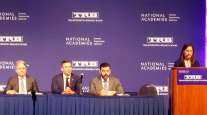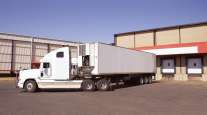Senior Reporter
Top Truck Bottlenecks Mostly the Same, Just More Congested

[Stay on top of transportation news: Get TTNews in your inbox.]
A familiar troublesome highway spot where Interstate 95 and New Jersey state Route 4 come together in Fort Lee, N.J., outside New York City, once again tops the list of the nation’s worst trucking chokepoints on the American Transportation Research Institute Top 100 Truck Bottlenecks list, released Feb. 13.
The Atlanta metro area and its I-285 perimeter stand out as the most gridlocked highway in the country by claiming three of the top 10 spots on the list. Chicago and Houston each have two highway interchanges in the Top 10, while Los Angeles and Nashville, Tenn., each have one.
The Fort Lee location has been in the Top 10 for more than 10 years and it has been the most congested location now for six consecutive years.
“This location is right next to Manhattan and you have tremendous consumer demand for all the things that come on trucks and you have people and it is just a perfect storm causing a big congestion chokepoint for everybody,” ATRI President Rebecca Brewster told Transport Topics.
The ATRI report presents a disturbing picture for professional truck drivers as its 2023 data shows congestion is increasing, in some cases because of increased work zones and heavy construction brought on by projects initiated by the Infrastructure Investment and Jobs Act, which is pouring hundreds of billions into repairing roads, highways and bridges.
The report said the average rush hour truck speeds were 34.4 mph, down 3.8% from 2022. Among the top 10 locations, the average rush hour truck speeds were 28.5 mph, down 4.4% year-over-year.
“Traffic congestion on our National Highway System inflicts an enormous cost on the supply chain and environment, adding $95 billion to the cost of freight transportation and generating 69 million metric tons of excess carbon emissions every year,” American Trucking Associations President Chris Spear said. “The freight bottlenecks identified in this report provide an actionable blueprint for state and federal transportation officials on where to invest infrastructure funding most cost-effectively. Increasing freight efficiency should be a top priority for the U.S. [Department of Transportation], and alleviating these bottlenecks would improve highway safety, protect the environment and support interstate commerce.”
As it was in 2023, the second-most congested interchange is I-294 at I-290/I-88, just a few miles west of Chicago. Two years ago the interchange was not in the top 20 and now this section of the Illinois Tollway is undergoing a multiyear, multibillion-dollar reconstruction project.
“The roads are not getting better, right now,” Brewster said. “As we see the money from the infrastructure law play out, anytime you have work zones you will have increased congestion, but the good news is once that work is complete I would expect to see these locations improve.”
The third-most congested highway area is also in Chicago, on the heavily traveled North-South I-55, near Midway Airport.
The fourth-place bottleneck — Houston’s I-45 and I-69/U.S. 59 — is the subject of a state proposal for a now $9 billion reroute and reconstruction plan centered on I-45. The Texas Department of Transportation now says it’s close to beginning construction after years of opposition from community groups who wanted changes made to the project’s design.
Three Atlanta bottlenecks on I-285 capture spots five, six and nine.
The infamous “Spaghetti Junction” in Atlanta’s northern DeKalb County at I-285/I-85 North is fifth, followed by I-285 West and I-20 in western Fulton County. That area is home to numerous trucking companies that service the metro area, as well as a major UPS distribution center. Hartsfield-Jackson Atlanta International Airport and its important air cargo hub is just eight miles away and Georgia is taking on a much larger role in the growing automotive and transportation sector, with numerous plants either operating or under construction.
Atlanta’s I-285 at state Route 400 is in the ninth spot on the ATRI list.
“I live here in Atlanta and I see these bottlenecks on a daily basis,” Brewster said. “There is such a commitment on the part of the Georgia DOT to invest in infrastructure and fix these bottlenecks with redesigns, and adding additional lanes and they’re doing whatever it takes to make this traffic flow.”
The mingling of California’s state Routes 60 and 57 in eastern Los Angeles County ranks seventh on the ATRI Top 10. Work is underway on the final and most important phase of a project that aims to relieve congestion at the worst truck bottleneck in California. Last summer, officials broke ground on the $441 million Phase III of the project in the cities of Diamond Bar and the City of Industry. The project was originally slated to launch in 2025 but the L.A. Metro Board of Directors voted in January to accelerate funding of the project.
As we see the money from the infrastructure law play out, anytime you have work zones you will have increased congestion, but the good news is once that work is complete I would expect to see these locations improve.
ATRI President Rebecca Brewster
Image
Houston’s I-10 at I-45 interchange ranks eighth.
Nashville’s I-24/I-40 at I-440 East interchange occupies the 10th spot.
ATRI compiled the data from 325 locations on the National Highway System. The analysis, based on an extensive database of freight truck GPS data, uses several customized software applications and analysis methods, along with data from trucking operations to produce a congestion impact ranking for each location. ATRI’s truck GPS data is also used to support numerous state and federal freight mobility initiatives.
For access to the full report, including detailed information on each of the top 100 most congested locations, visit ATRI’s website, truckingresearch.org.
Want more news? Listen to today's daily briefing below or go here for more info:





